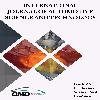Comparative analysis of full car model with driver using PID and LQR controllers
In this study, an active suspension model is proposed to increase the driving safety and passenger comfort of the car, which is adversely affected by car-road interaction. In this context, the full car model with a driver is considered as eight degrees of free-dom. All the motion equations of the car were determined by the Lagrangian method and converted into state-space forms. Then, these equations are solved precisely by us-ing Euler's method in Matlab software. PID and LQR controllers are designed to reduce the vertical displacement of the passenger and the rotational movements of the car. In order to evaluate the performance of the designed controllers, two different road inputs and two different car speeds are taken into account. In the simulation results, the verti-cal displacement and acceleration values of the driver and the rotational movements of the car were examined. While the PID controller stands out in damping the dis-placement values at low speeds, the LQR controller is much more successful in other cases.
Keywords:
: Full car model Active suspension control, Ride control, PID, LQR,
___
- Altun Y. Çeyrek Taşıt Aktif Süspansiyon Sistemi için LQR ve LQI Denetleyicilerinin Karşılaştırılması. Gazi Üniversitesi Fen Bilim Derg Part C Tasarım ve Teknol [Internet]. 2017;5(3):61–70. Available from: http://dergipark.gov.tr/http-gujsc-gazi-edu-tr/issue/31140/338335
- Nagarkar M, Bhalerao Y, Patil GV, Patil RZ. Multi-Objective Optimization of Nonlinear Quarter Car Suspension System - PID and LQR Control. Procedia Manuf [Internet]. 2018;20:420–7. Available from: https://doi.org/10.1016/j.promfg.2018.02.061
- Sever M, Şendur HS, Yazıcı H, Arslan MS. Biodinamik sürücü modeli içeren bir taşıt süspansiyon sisteminin durum türevi geri beslemeli LQR ile aktif titreşim kontrolü. Gazi Üniversitesi Mühendislik-Mimarlık Fakültesi Derg. 2019;3:1573–1572.
- Özdemir A, Maden D. Aktif süspansiyon sistemli çeyrek araç modelinin gözlemleyiciyle optimal kontrolü Optimal ob-server control of quarter car model with active suspension. SAÜ Fen Bil Der. 2013;17(2):181–7.
- Singh D. Active Vibration Control of Passenger Seat in Quarter Car Model using Supertwisting Controller. Int J Control Autom. 2017;10(11):83–94.
- Agharkakli A, Sabet GS, Barouz A. Simulation and Analysis of Passive and Active Suspension System Using Quarter Car Model for Different Road Profile. Int J Eng Trends Technol. 2012;3(5):636–44.
- Okuturlar H, Tınkır M. Araç süspansiyon sisteminin nümerik ve deneysel dinamik analizi. Konya J Eng Sci. 2021;9(1):85–105.
- Ben LZ, Hasbullah F, Faris FW. A comparative ride performance of passive, semi-active and active suspension systems for off-road vehicles using half car model. Int J Heavy Veh Syst. 2014;21(4):26–41.
- Gandhi P, Adarsh S, Ramachandran KI. Performance Analysis of Half Car Suspension Model with 4 DOF using PID, LQR, FUZZY and ANFIS Controllers. Procedia Comput Sci [In-ternet]. 2017;115:2–13. Available from: https://doi.org/10.1016/j.procs.2017.09.070
- Khodadadi H, Ghadiri H. Self-tuning PID controller design using fuzzy logic for half car active suspension system. Int J Dyn Control. 2018;6(1):224–32.
- Yildirim E, Esen I. Dynamic Behavior and Force Analysis of the Full Vehicle Model using Newmark Average Acceleration Method. Eng Technol Appl Sci Res. 2020;10(1):5330–9.
- Khan L, Qamar S, Khan MU. Comparative analysis of adaptive neurofuzzy control techniques for full car active suspension system. Arab J Sci Eng. 2012;39(3):2045–69.
- Dugard L, Sename O, Aubouet S, Talon B. Full vertical car observer design methodology for suspension control applications. Control Eng Pract [Internet]. 2012;20(9):832–45. Available from: http://dx.doi.org/10.1016/j.conengprac.2012.04.008
- Hanafi D. PID controller design for semi-active car suspension based on model from intelligent system identification. 2010 2nd Int Conf Comput Eng Appl ICCEA 2010. 2010;2(3):60–3.
- Guclu R, Metin M. Fuzzy logic control of vibrations of a light rail transport vehicle in use in Istanbul traffic. JVC/Journal Vib Control. 2009;15(9):1423–40.
- Özmen İ, Közkurt C. Design of Fuzzy Logic Support-ed Car Driver Control System. Int J Automot Sci Technol. 2021;5:228–38.
- Doğan H, Kaplan K, Kuncan M, Ertunç HM, Üniversitesi K. Araç Süspansiyon Sistemi Kontrolüne PID ve Bulanık Man-tık Yaklaşımları PID and Fuzzy Logic Approach to Vehicle Suspension System Control Mekatronik Mühendisliği Bölümü. 2015;(January 2015):10–2.
- Emam AS. Fuzzy Self Tuning of PID Controller for Active Suspension System. Adv Powertrains Automotives. 2015;(January 2015).
- Eroğlu M, Koç MA, Kozan R, Esen İ. Self-tuning fuzzy logic control of quarter car and bridge interaction model. Sak Univ J Sci. 2021;25(5):1197–209.
- Paksoy M, Guclu R, Cetin S. Semiactive self-tuning fuzzy logic control of full vehicle model with MR damper. Adv Mech Eng. 2014;2014.
- Yağız N, Yüksek İ. Robust Control of Active Suspensions Using Sliding Modes. Env Sci. 2001;25:79–87.
- Cakir MF, Bayraktar M. Modelling of main battle tank and designing LQR controller to decrease weapon oscillations. J Fac Eng Archit Gazi Univ. 2020;35(4):1861–76.
- Aktas KG, Esen I. State-Space Modeling and Active Vibration Control of Smart Flexible Cantilever Beam with the Use of Finite Element Method. Eng Technol Appl Sci Res. 2020;10(6):6549–56.
- Eser O, Çakan A, Kalyoncu M, Botsalı F. AriAlgo-ri̇tmasi (AA) Ve Parçacik SürOpti̇mi̇zasyonu (PSO) Kullanarak Çeyrek AraçModeli̇ TasariParametreleri̇ni̇Beli̇rlenmesi̇. Konya J Eng Sci. 2021;8055:621–32.
- Kothandaraman R, Ponnusamy L. PSO tuned Adaptive Neuro-fuzzy Controller for Vehicle Suspension Systems. J Adv Inf Technol. 2012;3(1):57–63.
- Yayın Aralığı: Yılda 4 Sayı
- Başlangıç: 2016
- Yayıncı: Otomotiv Mühendisleri Derneği
Sayıdaki Diğer Makaleler
Review On Electric Vehicle Fire Hazards Associated with Batteries, Combustibles and Smoke
Anilkumar Shere, K A Subramanian
İlker Örs, Halil Erdi Gülcan, Bahar Sayın Kul, Murat Ciniviz, Savaş Yelbey
Mustafa Eroğlu, Mehmet Akif Koç, Recep Kozan, İsmail Esen
Kemal Ermiş, Mehmet Çalışkan, Anıl Okan
Electric vehicle fire hazards associated with batteries, combustibles and smoke
